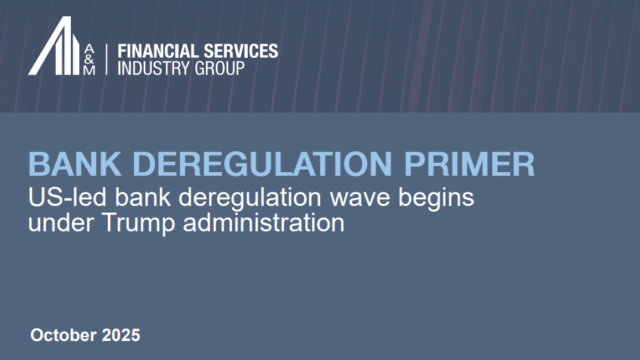The Future of Banking
The banking sector is unbundling. Regulators must respond, and banks must be bold.
We are several years into what Joseph Schumpeter would call a process of “creative destruction” in the banking sector. Yet only now is the outcome becoming clear. The major banks are seeing competitive forces “unbundle” their business models along product and functional lines. This will create a more diverse and fluid financial services eco-system, with many more institutions engaged in activities that form the building blocks of banking services. If the universal banking model is to survive, these new challenges will need to be carefully addressed.
In some senses, banks have traditionally been like department stores in that they provide a comprehensive range of products to very different customers. Like department stores, they are under competitive pressure arising from technological innovation and the growth of specialists. These challenges have been compounded for banks who have been facing significant and mounting regulatory restrictions, and have, for the most part, evolved with their supply chain fully integrated into their business model.
Banks originate their own raw material (cash), inventory it (balance sheet), structure it (create lending and deposit products), undertake research, process it (transactional banking) and distribute it (lend/provide credit). This degree of vertical integration is very unusual when compared with other sectors, and until recently it was an important barrier to entry.
In light of this overarching context, unbundling in the banking sector is taking place at two levels.
At the product level, the major banks are critically evaluating all their business lines, specialising and divesting non-core activities. Agglomeration of diverse banking activities with little to no synergies and with widely differing business and technological needs is being challenged. The trend is towards a smaller and simpler model. This is happening at a time when a new generation of specialised banking institutions is emerging. On the retail side, many are specialising in narrow client segments such as SME lending, buy-to-let and current accounts. In investment banking, M&A boutiques, Principal Trading Firms (PTF’s) and specialised research firms are growing rapidly.
Secondly, the relentless pace of technological change has facilitated and spurred a breakdown of the supply chains of traditional banking institutions. The internet has transformed the cost and channel for client acquisition. Deposits can be placed through price comparison sites. Neo-banks and digital banks provide customised interfaces with customers and eliminate the need for branches. The need for bank balance sheets is being reduced through peer-to-peer lending -- which today accounts for nearly 15 percent of all lending to SME’s in the UK – and the activities of mutual funds and asset managers. Institutions such as PayPal and Worldpay are providing payment services. Third parties provide analytical support. Blockchain technology is set to transform transactional banking and custody.
As the banking supply chain fragments, we’re likely to see many more institutions engaged in activities that form the building blocks of banking services. This proliferation of new institutions will in turn prompt a renewed move to consolidation, but along very different lines to the universal banks of the past. The process will be driven by a need to rationalise functions around best in class providers and activities with genuine and exploitable synergies rather than around a conglomeration of different functions.
The unbundling of banking will thus increase competition overall. This will need to be complemented with a robust regulatory environment based more on a functional rather than an institutional approach. Prudential standards and rules of conduct must be adapted to ensure they address the idiosyncrasies of specific functions and the risks they pose. Moreover, unbundling and the shift online will create important new forms of risk. Cyber-attacks could create systemic risks, and robo-advice could increase volatility through herding of decisions. These risks will need to be actively monitored and managed.
In summary, we are moving to a new ecosystem of banking, more specialised by product and activity. Unbundling does not spell the end of large universal banks, but there will be fewer of them. Those that do survive will only do so by reengineering their supply chains and demonstrating genuine synergies across their diverse set of activities. That will require clear-sighted leadership, and bold and dynamic decision-making. The analogy with the retail sector and the struggles of the high-street department stores is evident.
If you have any questions regarding the content discussed please feel free to get in touch with a member of our Financial Industry Advisory Services team.




